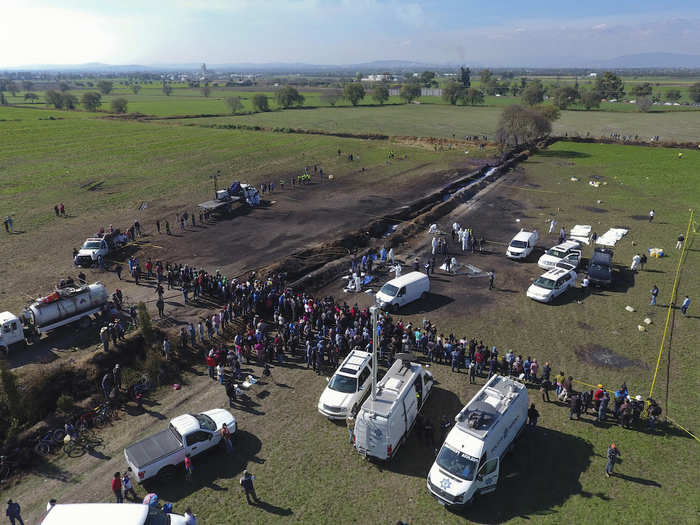
For some time, fuel theft was largely done by local thieves or by people from rural and isolated communities, who used stolen fuel for their own needs or sold it to supplement their income.
But in recent years, the lucrative nature of fuel theft — smuggling and reselling stolen fuel is often easier than illegal narcotics — has drawn in organized criminal groups, which bring a greater ability to corrupt and larger capacity for violence to the trade.
Organized criminal groups are able to use their connections to and control over law enforcement or Pemex workers to steal whole shipments in tanker trucks.

Source: Justice in Mexico project



The banners were hung in late January, after an operation in the area seized thousands of liters of stolen fuel. Afterward, residents in the area set up blockades with burning cars.
The cartel denied hanging the banner threatening Lopez Obrador, however, saying it was put up by rivals trying to attract attention from authorities.
Narcomantas, as these banners are known, have appeared throughout Mexico's war on drugs, hung by groups to claim credit for themselves or to cast attention on rivals.


Mexicans have protested in other areas where troops have been deployed to prevent fuel theft.
"When Lopez Obrador moved these people into those areas, the locals protested," Mike Vigil, former chief of international operations for the US Drug Enforcement Administration, told Business Insider. "The reason I think that the protest for the most part occurred is because they didn't want them there because a lot of them were involved in the theft of petroleum."
Source: Animal Politico

"It's very hard for people to change," Pedro Mendez, 52, who sells household goods in Santa Rosa de Lima, told Reuters this week, as heavily armed police patrolled and helicopters circled above. "The bad guys know how to get to them and that there are people who'll take money to do their bidding."
Source: Reuters, Associated Press

Yepez, the gang's leader, has evaded capture, though authorities said Wednesday they captured seven people linked to him, including his sister-in-law, believed to be his finance chief, and her husband, a federal police officer.
Authorities said the operation also recovered stolen vehicles and freed six kidnapping victims, including two police officers.
Police also raided a mansion belonging to Yepez, where they found several tunnels reminiscent of those used by Joaquin "El Chapo" Guzman, the Sinaloa cartel chief recently convicted of drug trafficking and other crimes in New York City.
Source: Animal Politico, Zona Franca


Guanajuato had long avoided the violence that has plagued much of Mexico over the past decade, but the number of homicides there has climbed precipitously in recent years.
There were 957 homicides in the state in 2015, according to government data. That rose to 1,096 in 2016 and to 1,423 in 2017. In 2018, there 3,290 homicides there, the most of Mexico's 32 states. There were 293 homicides in the state in January 2019 alone.
Guanajuato's rising violence has been driven by fuel theft and conflict among criminal groups, mainly the Santa Rosa de Lima cartel and the Jalisco New Generation cartel, Bosworth wrote in a mid-February report.
Source: Proceso


!["Even if they're clean now, and they're exposed and they succumb ... then that's going to also put them at risk [of] taking other bribes," Vigil said, citing a source as saying some in the security forces welcomed the new assignment, seeing it as less dangerous with more potential for profit. "Once they get a taste of corruption," Vigil added, "we've lost them in terms of ethics." "Even if they're clean now, and they're exposed and they succumb ... then that's going to also put them at risk [of] taking other bribes," Vigil said, citing a source as saying some in the security forces welcomed the new assignment, seeing it as less dangerous with more potential for profit. "Once they get a taste of corruption," Vigil added, "we've lost them in terms of ethics."](/thumb/msid-60085318,width-700,height-525/60085318.jpg)

 Tesla tells some laid-off employees their separation agreements are canceled and new ones are on the way
Tesla tells some laid-off employees their separation agreements are canceled and new ones are on the way Taylor Swift's 'The Tortured Poets Department' is the messiest, horniest, and funniest album she's ever made
Taylor Swift's 'The Tortured Poets Department' is the messiest, horniest, and funniest album she's ever made One of the world's only 5-star airlines seems to be considering asking business-class passengers to bring their own cutlery
One of the world's only 5-star airlines seems to be considering asking business-class passengers to bring their own cutlery The Future of Gaming Technology
The Future of Gaming Technology
 Stock markets stage strong rebound after 4 days of slump; Sensex rallies 599 pts
Stock markets stage strong rebound after 4 days of slump; Sensex rallies 599 pts
 Sustainable Transportation Alternatives
Sustainable Transportation Alternatives

Copyright © 2024. Times Internet Limited. All rights reserved.For reprint rights. Times Syndication Service.